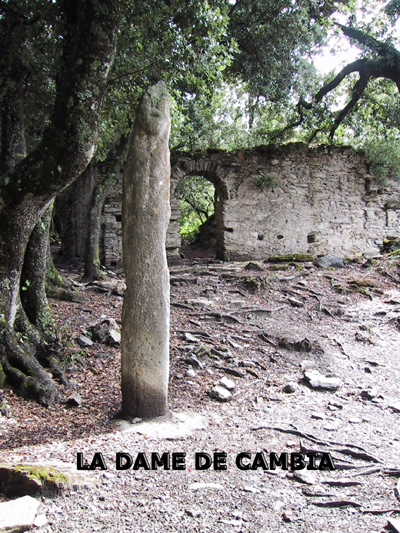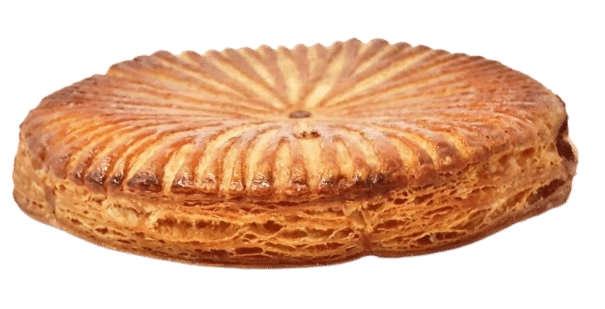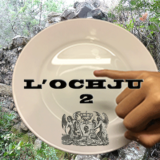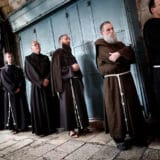HISTOIRE DE MENHIR

A Stantara di Santa Maria di Cambia :
En langue corse « A Stantara » signifie « Statue menhir ». Le passé de la Corse est jalonné d’énigmes, de mythes et de légendes. Les menhirs ont aussi leurs histoires. Ils n’ont pas fini de révéler tous leurs secrets, la clé de lecture de ces témoins du passé n’étant pas encore découverte.Cette statue-menhir en schiste découverte en 1893 mesure 2,30m et présente une silhouette particulièrement longiligne et anthropomorphe (de forme humaine) ; relevée à plusieurs reprises par les habitants du village, on ne peut pas certifier qu’elle se trouve à son emplacement originel.
Son contexte archéologique est intéressant car elle appartient aux statues septentrionales de nord de l’île (au-dessus de la ligne Ajaccio Solenzara) et présente leurs caractéristiques : un motif en relief sous le menton.Le visage est bien dessiné : les yeux, le nez, et la bouche sont bien marqués.La tête se détache du reste du corps, son sommet est en pointe, et l’ovale du menton est souligné. Des graffitis d’époques anciennes et récentes recouvrent le fût de la statue. Cette statue-menhir a été christianisée comme l’atteste la croix gravée sous les seins, qui sont représenté par deux cupules, mais surtout par celles des croix cupulées au nombre de deux. Plusieurs légendes concernent cette statue-menhir. L’une d’elle narre l’histoire d’une jeune fille qui aurait été pétrifiée d’épouvante en voyant un mort saisir le bâton qu’elle tentait d’introduire dans sa tombe à la suite d’un stupide pari. La mort l’aurait alors saisie, figeant dans la peur l’infortunée pour l’éternité.La seconde légende raconte qu’un jeune homme et une jeune fille se sont lancé un défi, celui de se rendre à minuit à la porte de l’église voisine et de provoquer un vampire qu’i s’y trouvait enfermé.A l’appel de la jeune fille, le jeune homme, caché dans l’église, aurait répondu et celle-ci, serait morte de peur. D’où, pour conserver sa mémoire, l’érection de la colonne très populaire connue sous le nom de Sainte. Les ruines de l’ancien couvent, (le couvent des Franciscains), ainsi que l’église romane du même nom, se dressent à proximité immédiate de la sculpture, ce qui confirme que le site était un lieu de passage fréquenté.
 In Stantara di Santa Maria di Cambia:
In Stantara di Santa Maria di Cambia:
In lingua corsa « A Stantara » significa « statua di Menhir ». Il passato della Corsica è pieno di enigmi, miti e leggende. Anche i menhir hanno le loro storie. Non hanno finito di svelare tutti i loro segreti, la chiave di lettura di questi testimoni del passato non ancora scoperti.Questa statua-menhir in scisto scoperta nel 1893 misura 2,30 m e ha una silhouette particolarmente lunga e antropomorfa (di forma umana); notata più volte dagli abitanti del villaggio, non possiamo certificare che si trovi nella sua posizione originale.Il suo contesto archeologico è interessante perché appartiene alle statue settentrionali del nord dell’isola (sopra la linea di Ajaccio Solenzara) e ha le loro caratteristiche: un motivo a rilievo sotto il mento.Il viso è ben disegnato: gli occhi, il naso e la bocca sono ben marcati.La testa si distingue dal resto del corpo, la sua parte superiore è appuntita e l’ovale del mento è sottolineato. I graffiti dell’epoca antica e recente ricoprono il fusto della statua. Questa statua-menhir è stata cristianizzata come testimonia la croce incisa sotto i seni, che sono rappresentati da due cupole, ma soprattutto dalle due croci coppulate. Diverse leggende riguardano questa statua-menhir. Uno di loro racconta la storia di una giovane ragazza che sarebbe rimasta pietrificata dall’orrore quando ha visto un uomo morto afferrare il bastone che stava cercando di introdurre nella sua tomba dopo una stupida scommessa. La morte l’avrebbe poi afferrata, congelando la sfortunata donna nella paura per l’eternità.
La seconda legenda racconta che un giovane uomo e una giovane ragazza si sfidarono ad andare alla porta della vicina chiesa a mezzanotte per provocare un vampiro che vi era rinchiuso.Al richiamo della ragazza, il giovane, nascosto nella chiesa, avrebbe risposto e la ragazza sarebbe morta di paura. Da qui, per conservarne la memoria, l’erezione della popolarissima colonna nota come Santa. Le rovine dell’ex convento (il convento francescano) e l’omonima chiesa romanica si trovano nelle immediate vicinanze della scultura, a conferma che il luogo era un luogo di passaggio molto frequentato.

At Stantara di Santa Maria di Cambia:
In Corsican language « A Stantara » means « Menhir statue ». The past of Corsica is full of enigmas, myths and legends. The menhirs also have their stories. They haven’t finished revealing all their secrets, the key to reading these witnesses of the past not yet having been discovered.This statue-menhir in schist discovered in 1893 measures 2.30m and has a particularly long and anthropomorphic silhouette (of human form); noted several times by the inhabitants of the village, we cannot certify that it is in its original location.Its archaeological context is interesting because it belongs to the northern statues of the north of the island (above the Ajaccio Solenzara line) and presents their characteristics: a relief pattern under the chin.The face is well drawn: the eyes, the nose, and the mouth are well marked.The head stands out from the rest of the body, its top is pointed, and the oval of the chin is underlined. Graffiti from ancient and recent times covers the shaft of the statue. This statue-menhir has been Christianized as evidenced by the cross engraved under the breasts, which are represented by two cupules, but especially by the two cupulated crosses. Several legends concern this statue-menhir. One of them tells the story of a young girl who would have been petrified with horror when she saw a dead man grab the stick she was trying to introduce into her grave following a stupid bet. Death would then have seized her, freezing the unfortunate woman in fear for all eternity.
The second legend tells that a young man and a young girl challenged each other to go to the door of the nearby church at midnight and provoke a vampire who was locked up there.At the call of the girl, the young man, hidden in the church, would have answered and the girl would have died of fear. Hence, to preserve her memory, the erection of the very popular column known as Saint. The ruins of the former convent, (the Franciscan convent), as well as the Romanesque church of the same name, stand in the immediate vicinity of the sculpture, confirming that the site was a busy place of passage.

In Stantara di Santa Maria di Cambia:
In der korsischen Sprache bedeutet « A Stantara » « Menhir-Statue ». Die Vergangenheit Korsikas ist voller Rätsel, Mythen und Legenden. Auch die Menhire haben ihre Geschichten. Sie haben noch nicht alle ihre Geheimnisse enthüllt, der Schlüssel zum Lesen dieser Zeugen der Vergangenheit ist noch nicht entdeckt worden.
Dieser 1893 entdeckte Schiefermenhir misst 2,30 m und hat eine besonders lange und anthropomorphe Silhouette (in menschlicher Gestalt); von den Bewohnern des Dorfes mehrmals bemerkt, können wir nicht bestätigen, dass er sich an seinem ursprünglichen Standort befindet.Sein archäologischer Kontext ist interessant, weil er zu den nördlichen Statuen des Nordens der Insel gehört (oberhalb der Ajaccio-Solenzara-Linie) und ihre Merkmale aufweist: ein Reliefmuster unter dem Kinn.Das Gesicht ist gut gezeichnet: Die Augen, die Nase und der Mund sind gut markiert.Der Kopf hebt sich vom übrigen Körper ab, seine Spitze ist spitz, und das Oval des Kinns ist unterstrichen. Graffiti aus der Antike und der jüngsten Zeit bedecken den Schaft der Statue. Dieser Statuen-Menhir ist christianisiert worden, wie das unter den Brüsten eingravierte Kreuz, das durch zwei Kuppeln dargestellt wird, aber vor allem durch die beiden kuppelartigen Kreuze belegt wird. Über diesen Statuen-Menhir gibt es mehrere Legenden. Eine davon erzählt die Geschichte eines jungen Mädchens, das vor Entsetzen versteinert gewesen wäre, als sie sah, wie ein toter Mann den Stock ergriff, den sie nach einer dummen Wette in ihr Grab bringen wollte. Der Tod hätte sie dann ergriffen und die unglückliche Frau für alle Ewigkeit in Angst eingefroren.
Die zweite Legende erzählt, dass ein junger Mann und ein junges Mädchen sich gegenseitig herausforderten, um Mitternacht zur Tür der nahe gelegenen Kirche zu gehen und einen dort eingesperrten Vampir zu provozieren.Auf den Ruf des Mädchens hätte der junge Mann, der sich in der Kirche versteckt hatte, geantwortet und das Mädchen wäre vor Angst gestorben. Daher wurde zur Bewahrung ihres Andenkens die sehr beliebte Säule mit dem Namen « Saint » errichtet. Die Ruinen des ehemaligen Klosters (Franziskanerklosters) sowie die gleichnamige romanische Kirche stehen in unmittelbarer Nähe der Skulptur und bestätigen, dass der Ort ein belebter Durchgangsort war.












